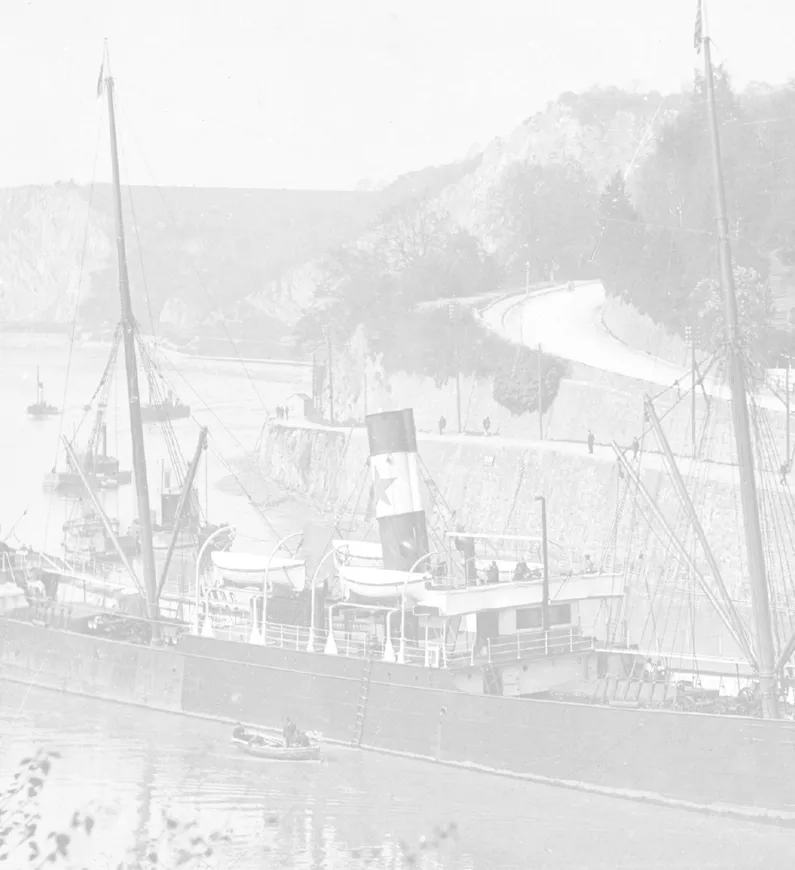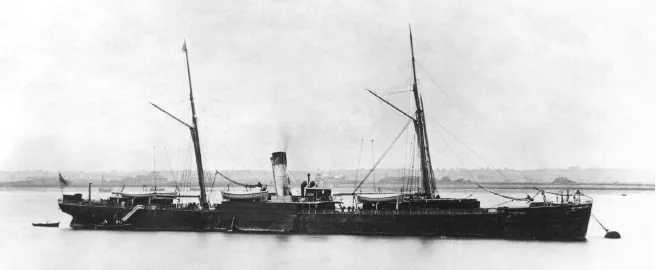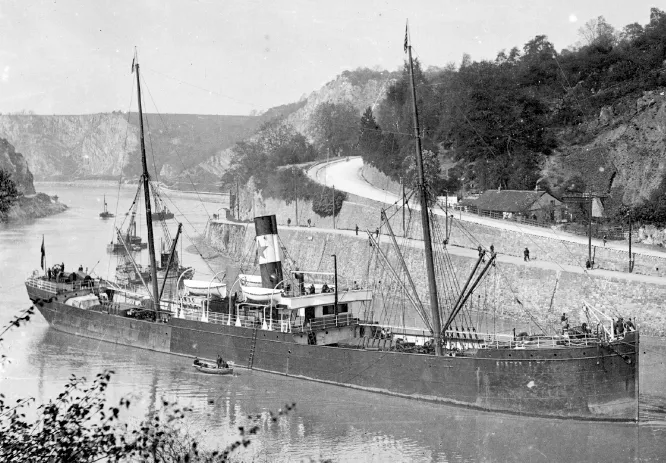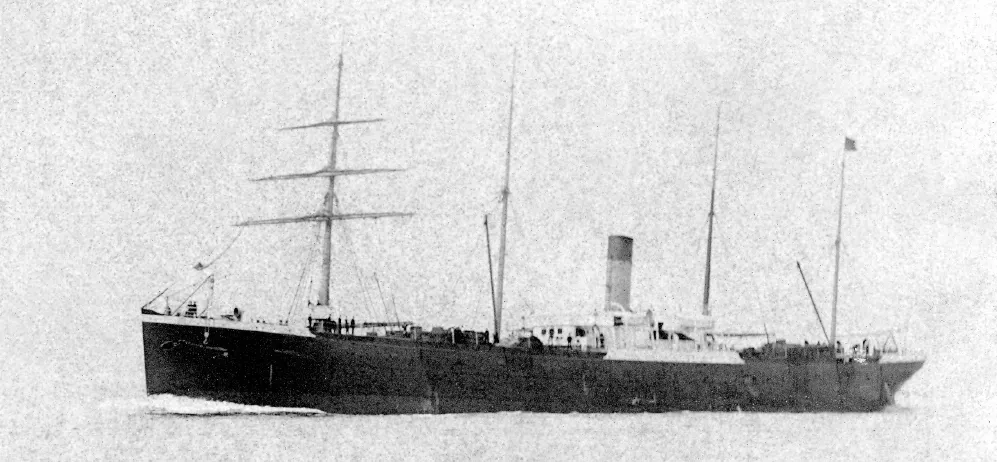![]()
CHAPTER
1
Origins and Early Years
Two significant events brought a revolution in ocean transport in the nineteenth century; the first was the introduction of steam propulsion and the second the gradual replacement of the paddle by the screw propeller. Development tended to revolve around passenger ships in the North Atlantic trade, in which competition was fiercest, but it was competition in the West Indies trade that led Liverpool shipowner Alfred Holt and his brother Philip to change direction in 1864 and try their luck against the sailing ships engaged in the China trade. Alfred, a trained railway engineer, had designed a new type of compound tandem steam engine with high-pressure boilers, which proved to offer lower fuel consumption during tests in their steamer Cleator. The brothers established the Ocean Steam Ship Company and built three new 2,280gt steamships fitted with the new engines at Scott & Company of Greenock. Agamemnon, Ajax and Achilles were iron, three-masted ships with the somewhat unusual arrangement of the rudder being mounted forward of the screw. Their instant commercial success resulted in a decision to concentrate on the carriage of cargo, although all the early Holt ships continued to carry passengers for a number more years. The opening of the Suez Canal in 1869 reduced the voyage to and from the Far East by more than 3,000 miles and underlined the superiority of the steamship over sail. Thus were sown the first seeds of what later developed into the cargo liner.
The first successful shipment of live cattle across the Atlantic was made by the European (H N Hughes & Nephew) in July 1874 and subsequently many passenger/cargo ships had temporary stalling arranged on the upper deck. This in turn led to the development of a new type of purpose-built cattle carrier in the late 1880s but the trade declined shortly before World War II, when the fast-expanding United States needed to retain its livestock to feed its own burgeoning population. Meanwhile, developments in refrigerating techniques had finally enabled frozen meat to be transported long distances at sea, initially from the River Plate and later from Australia and New Zealand. Demand was such that the final decade of the nineteenth century saw increasing numbers of new insulated steamers coming off the ways, primarily for British owners.
Increasing availability of the new triple-expansion engines in the 1880s greatly aided the development of the cargo liner, which had become much more substantial and had almost tripled in size compared with the early Holt ships. In mainland Europe, liner companies from Germany and Holland, which had previously concentrated on ships carrying a mix of passengers and cargo, were also starting to invest in ships designed solely for the carriage of freight, as existing ships were unable to cope with the growing amounts of cargo on offer.
Note: An asterisk in a caption indicates the vessel shown in the photograph.
Far East beginnings
The origin of the cargo liner owes a great deal to the early steamers of that great British shipowner Alfred Holt. His 2,072gt Antenor completed by Andrew Leslie & Company, Hebburn-on-Tyne, in 1872 was the last of four sisters, which were two-masted developments of the pioneering Agamemnon trio. She measured 322ft and was driven at a modest ten knots by a two-cylinder compound tandem engine, speed being considered secondary to reliability and regularity of service by her fastidious owner. Like most early cargo steamers, she also carried a number of passengers, either on deck or in the ’tween deck. Along with Patroclus and Glaucus she was transferred to Holt’s Dutch subsidiary N S M ‘Oceaan’ in the early 1890s and all three had been sold to Japan by 1898, Antenor serving as Tateyama Maru until broken up in 1929.
MacGregor, Gow & Company’s Glen Line was one of Holt’s great rivals in the UK–Far East trade. The 2,985gt Glenfruin and Glenavon were built of iron to a three-island design by London & Glasgow Engineering & Iron Shipbuilding Company, Govan, in 1880–1. They had a registered length of 360ft on a beam of 43ft and were considerably faster than the Holt ships, being capable of steaming at thirteen and a half knots by means of a two-cylinder compound inverted engine developing 3,000ihp. Like the Holt ships, however, they also carried a number of passengers. This view purports to show Glenavon loading at an anchorage in Japan shortly before she was wrecked off the Chinese coast on Lintang Rock near Sa Mun in December 1898. Glenfruin became McIlwraith McEacharn’s Kalgoorlie in 1897 and was laid up after grounding at Singapore in 1910. Sold to local owners, she was hulked but was rebuilt in 1917 for Ho Hong Steamship Company and renamed Hong Hwa a year later. She was finally broken up in Osaka in 1934 after a remarkable fifty-four-year-long career. Glen Line concentrated on speed and some of its later ships could steam at up to fifteen knots, making a number of record passages. This proved expensive and, coupled with fierce competition with P&O in the passenger business, led the company to switch to slower, more economical, cargo-only ships at the turn of the century.
Established in Liverpool in 1877, the firm of Greenshields, Cowie operated the Knight Line to the Far East and its Knight Errant, shown in the Suez Canal, was a typical example of an early cargo steamer still retaining crossed yards. She was completed by Palmers, Jarrow, in the last month of 1885 and measured 3,471gt on dimensions of 330ft overall by 43ft. Propulsion was by means of a 350nhp reciprocating engine. In 1897, she was renamed Kensington by new owners and was broken up in the first quarter of 1910. A second Knight Errant, built by Charles Connell & Company, Glasgow, in 1898, was a much larger (470 x 57ft), four-masted steamer which, after sale in 1914, passed through four different ownerships until 1925, when she was converted into the whale factory/tanker Lancing by Melsom & Melsom of Larvik. She was notable in being the first of this type to be fitted with a stern ramp, and was eventually torpedoed by U522 on 7 April 1942 in the vicinity of Cape Hatteras. The Knight Line was sold to Alfred Holt in 1917.
Charles Hill’s Bristol City Line ran a service from its West Country homeport to the US east coast. Its 2,140gt Exeter City, seen here negotiating the Avon Gorge, was built by Blyth Shipbuilding & Dry Docks Company in 1887 and represented the smaller type of cargo steamer engaged in regular liner trade. Her hull was built on the three-island principle, a design widely favoured by tramp-ship owners and at that time there was not much to differentiate the two types, except for Exeter City and her consorts having more lifeboats. Length was 289ft between perpendiculars on a beam of 39ft and she was driven by triple-expansion machinery at around ten knots. After an uneventful career, she was broken up in Genoa in the summer of 1925.
Cattle carriers
White Star Line’s 4,639gt Cufic was a ship of several firsts. Not only was she the company’s first cargo ship and first to be driven by triple-expansion engines, but also she was the first North Atlantic ship to incorporate specific stabling facilities for the transportation of live cattle. Completed in Belfast by Harland & Wolff in the final month of 1888, she operated in the Liverpool–New York trade and was joined by sister Runic* the following year, both being capable of transporting 1,000 head. Over the following seven years, Harlands delivered six increasingly large, twin-screw ‘cattle boats’: Nomadic and Tauric (461 x 49ft) in 1891, Naronic and Bovic (470 x 53ft) in 1892, Cevic (500 x 60ft) in 1894 to replace Naronic, which had gone missing in February 1893, and finally Georgic in 1895, which was the largest of all the transatlantic cattle carriers at 10,077gt on dimensions of 559 x 60ft. Cufic was chartered to Spain’s Cia Transatlántica as Nuestra Senora de Guadaloupe during 1896–8; in 1901 she became Dominion Line’s Manxman, retaining the name through two more ownerships until foundering in the Atlantic a week before Christmas in 1919. Sister Runic became West India & Pacific Steamship Company’s Tampican in 1895 and was transferred to Leyland Line in 1899. In 1913 she was converted to the whale-oil tanker Imo by South Pacific Whaling and on 6 December 1917 was involved in a massive tragedy in Halifax, Nova Scotia, after colliding with the French steamer Mont Blanc. The latter’s ammunition cargo exploded, killing some 3,500 and wounding another 8,000, as well as destroying 3,000 homes. Miraculously, Imo survived and in 1918 became the Norwegian Guvornoren, but she was lost on 30 November 1921 after grounding in the Falklands.
In 1895, Cunard Line built its first cargo/cattle carriers, the twin-screw Sylvania* and Carinthia, for Liverpool–Boston service. They were constructed on the Clyde by the London & Glasgow company and measured 5,598gt on a registered length of 445 x 49ft. Two sets of triple-expansion engines provided a sea speed of thirteen knots and they had flush-decked hulls with boats carried on the weather deck. Carinthia was chartered by the British government in 1899 to carry mules from New Orleans to South Africa for the Boer War campaign but was wrecked in May 1900 on Gravois Point, Haiti. Sylvania was broken up in Italy in 1910.
Elder Dempster Lines built a number of cargo/cattle steamers for a new North Atlantic service, which it inaugurated in 1894. Depicted here is the 8,644gt four-master Montreal completed by C S Swan & Hunter, Newcastle, late in 1899. She measured 470 x 56ft and her twin-screw triple-expansion machinery gave a speed of thirteen knots. Employed initially as a Boer War horse and mule transport, she was transferred to Canadian Pacific Railway along with Elder Dempster’s other North Atlantic ships in April 1903. In 1915, she served for a while as a World War I troop transpor...







